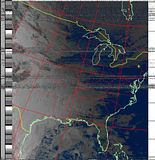My comment was for all satellites, geostationary, LEO, etc. Some satellites use circular polarity to make it easier on the receiving station so they don't have to worry about rotating polarity when installing an antenna or when tracking, just point AZ and EL and your done. Or in the case of polar or LEO sats, circular pol basically eliminates any polarity fading.
LEO or polar orbit weather sats have earth sensors to keep the cameras and antennas pointed toward earth and I'm not aware of any weather sats that have any spinning motion on the antennas. Usually antenna motion on a spacecraft is limited to small and cheap satellites with no station keeping like amateur, cube sats, Sputnik, etc.
Before I digress too far, my original point is if the satellite antenna was spinning it would not create circular polarity but that would be a good candidate for using a circular pol antenna to minimize any rotation effects.
As a side note, generally all satellites that have on board station keeping have a low gain omni directional antenna that's used for getting the spacecraft into orbit before the main antennas are deployed and especially if the spacecraft is tumbling and its also used in emergencies when the satellite screws up and the main antennas point away from earth.
Its interesting (to me) that the omni antenna used when the spacecraft is potentially tumbling is usually a linear pol Bicone, basically a fat dipole and that would be subject to rotational fading, but that seems to be the industry standard.
prcguy (and retired satelliteguy)
I'm not talking about the Geo sats but the Polar sats.......



